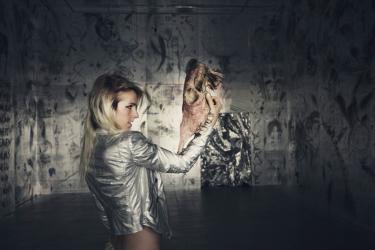‘I strive to make art that would evoke a similar shock to jumping in an ice-cold body of water,’ successful CU-Boulder alumna says
As a classically trained, now expressionist, painter, Lisa Solberg (BFA 2005) never imagined she’d be in an industrial-district studio, recruiting strippers.
It’s for a Dec. 19, 2015, exhibition—her largest to date—called Mr. Lee’s Shangri-La, featuring exotic dancers, a greenhouse of golden walls and her paintings. The show will be held at the progressive Los Angeles MAMA Gallery, with a preview at international premier art fair, Art Basel, in Miami Beach, Florida.
Her performance installation art, which clearly is not boring, is a natural evolution, Solberg explains. “Art is actually life, and I think most people are yearning for a change in perspective, a jolt of inspiration, a fresh breath of air. I strive to make art that would evoke a similar shock to jumping in an ice-cold body of water.”
Originally from Chicago, Solberg’s life is as eclectic as her work. She’d rather we not focus on her ski career, but the 5-feet-7-inch, green-eyed blonde skied in the X Games and is photographed often, brush in hand, donning a Michael Jordan jersey for super-hip contemporary art magazines.
As a youngster with raw exuberant talent, Solberg felt compelled to sketch on walls and draw on streets with chalk. Today her massive works utilizing broad, sweeping strokes in vibrant, energetic colors sell in a range of $5,000 to $30,000 in galleries from New York to Singapore.
If everyone was just happy, that would be insanely boring, wouldn’t it?”
When asked to take over an L.A. gallery space in 2012, she fearlessly delved into the dark side of dream imagery, sketching skulls and demons juxtaposed with messages of “everlasting love” in electric blue ink on floor-to-ceiling silver insulation boards.
The result was an immersive installation called STALKER; one that remains close to her heart and that revealed a raw and honest beauty. This year, when asked to do something artsy with a defunct Sno-Cat® atop a Utah ski resort, she went to work with gold paint and bright lights, creating a snow-mountain centerpiece.
Whether she’s using ink, oils, canvas or a vehicle, her artistic process remains intensely physical and emotionally intuitive, says Solberg, whose home base is an industrial L.A. studio.
“I’m surrendering to the moment,” she says, “as well as studying and learning from the void.”
From the Flatirons to industrial L.A.
Growing up in a family of five kids, art offered an escape, Solberg says.
“I have always been considered the ‘weird’ one of the family (although I might contend that!) … spending lots of time in the basement of my home drawing. I was happiest alone for a while there. It was kind of dark times self-inflicted from deep down—who knows why—and art was always my emotional outlet.” On the flip side, Solberg was playing on numerous varsity athletic teams and attributes her continued work ethic and mindset to her athletic upbringing.
Illinois’ Barrington High School held a large art department with four advanced-placement classes, nine instructors and 900 visual art students. Solberg found a mentor in teacher Blake Mueller. “He opened up so many paths for us as young artists and taught us that there are no boundaries.”
Striking a postmodern Hamlet-like pose, Lisa Solberg contemplates art, life, the universe and everything in her STALKER installation. Photo by Abby Ross.
Mueller, who is retired, has fond memories of Solberg. “I remember Lisa vividly as a gifted student who had determination with independent thought. She also had innate ability, perseverance and a grasp of factual and conceptual ideas that allowed her to perform at a competence level far beyond others at her age. I am proud of Lisa’s accomplishments, her passion for the visual arts is commendable and the size and scope of her art is fascinating.”
Although recruited by national art schools, Solberg was sold on CU.
“What’s interesting is my family actually went to Boulder when I was 10, and I remember saying, ‘I’m going to go to school here.’ I was getting ready to apply to Dartmouth where my dad and my grandfather went, but I applied (to CU) … because I didn’t have to write an essay. I was happy with my decision, though, very happy.”
CU’s psychology and astronomy classes filtered into her artistic conceptions, as did life beneath the Flatirons.
“I’d run a lot up into the Canyon toward Nederland, or up to the Flatirons. A lot of my inspiration came from there. I also had two great notable teachers, Sally Elliott and Jerry Kunkel,” she recalls.
“CU was my spring board; it propelled me to polish certain areas of study and interests in my work. That’s kind of how I see my time there, a time when you start to find out who you are through your studies and your work. I’m continually advising students to do things they are scared of. To believe in themselves, before anything else.”
“Being in downtown L.A. has been great for my career as a whole (I’ve been here seven years) but at the same time, I’m really yearning to get back out into nature.”
Coco Bunny
One advantage of a downtown L.A. studio is the opportunity for installation art. This fall, Solberg was selected by The Standard Hotel to feature several large images in a row of her black-and-white sketch of a cartoony Coco Bunny on its 40-by-8 foot wall along 6th Street.
Coco Bunny is her avatar, Solberg says, defined as an “existential rabbit and psychic guide to the light.”
With one paw waving in the air, much like the Chinese fortune cat Maneki Neko, Coco Bunny was created as an “image to provoke curiosity on her business cards, it was just the bunny one side and my name on the other,” she says.
Wherever she goes, Solberg tends to leave behind a smaller cut-out version of the bunny—as seen in photographs (or photo bombs) on people, phones, cars, buildings and sidewalks.
“It’s cute, funny, hardcore, rebellious, flirty, experimental and intelligent. CB has a zest for life, and is stuck all over the world to make people happy. Its motto is, “’I like you.’”
When she’s not Coco Bunny, Solberg prefers that people react to her art from a gut level, because that is how she approaches it.
“I would advise not trying too hard. With my art, I’m trying to evoke raw emotion most of the time. For me it’s a personal process but its exposure becomes entirely public, and that’s what I want it to be. Any given piece of my work can mean something entirely different to the person right next to you, and this is what I enjoy most.”
In 24HR PSYCHIC, it’s quite the opposite process, having a conceptual project “ghost gallery” that requires the viewer to take a moment and contemplate, to look at their reflection, to look into themselves.
“By definition, 24HR PSYCHIC inherits the ability to hold events in any physical or non-physical place (hence, ‘ghost’ gallery), this crucial aspect grants me the freedom to basically do whatever I want with it—letting it evolve as necessary.”
Her authenticity is what inspired David Wallin, an Australian art student whom she met studying abroad in 2002, at the University of Wollongong, south of Sydney.
“I’d freshly migrated from mechanical engineering, so I was still finding my depth in the creative world,” Wallin recounts. “Being quite an analytical person, Lisa helped me loosen up my creative brain, live in the moment and not be afraid to get things out on paper, rather than trying to perfect things in my head.”
One of the most vivid things he recalls is her dedication to documenting her process and collecting her ideas, thoughts, sketches and experiences in 10 large art journals.
“I was blown away by the level of detail and the diligence with which she recorded her everyday life, and how much this fed back into her creative output,” he says.
“It’s been great seeing Lisa’s creative development, there’s a real rawness and quickness in her work, but it’s underpinned by a much deeper level of thought. It’s like she stores away so many little memories, impressions and experiences of the world and then they all come tumbling out in that vibrant, moody, expressive way until she’s done. For that moment.”
“For me, Lisa contributes a s—- load of fearlessness to the world. She’s an adventurer, an experience collector, an inspiration to follow what you’re passionate about. She’s honest. She’s right there in her experiences, and documents her feelings and passions in one beautiful hot mess of color and line.”
Solberg boils it down to the fact she’s not necessarily trying to make people happy—since “that’s what Coco Bunny is for,” she says.
“But instead I’m trying to invigorate people’s sense of life. If everyone was just happy, that would be insanely boring, wouldn’t it?”
Julie Marshall (MA Jour’95) is the author of Making Burros Fly: Cleveland Amory, Animal Rescue Pioneer, and a former features writer/associate editor for the Daily Camera. She lives in Lafayette. For more about Lisa Solberg, click here.






